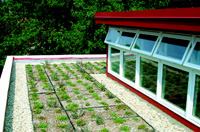Commercial projects in the U.S. increasingly incorporate green roofs, and now interest from home builders and owners is growing as well. High-end homeowners who are environmentally committed are especially aware of green roofs, according to Melissa Muroff, COO of Roofscapes Inc.
Between 2004 and 2005, total green roof square footage grew 80 percent in the U.S., according to Green Roofs for Healthy Cities’ recent Green Roof Industry Survey. The reasons are simple and varied. In commercial and residential applications, green roofs control storm water, replace green spaces, improve air quality, extend the life of roof surfaces, and greatly reduce solar heat gain, which reduces cooling costs.
Most green roofs are multi-layered, built-in-place systems for flat roofs that are several thousand square feet in size. These systems are rarely used on homes because they are extremely expensive, heavy, and hinder roof repair.
But some green roofs are designed for simpler installation. These modular systems come in several formats and sizes and utilize a portable framework of woven or molded plastic or metal containers for the growth media and plants. The modules are easier and faster to install than commercial systems and most come pre-planted. Stabilizing components make them usable on steep-slope roofs, and the modules can be easily removed for roof repair, says Sandra McCullough, marketing manager for Weston Solutions, maker of the GreenGrid system. Most modular systems must be installed over a drainage product applied to the roof surface.
A roof’s dead load capacity is a critical factor in determining what type of green roof is feasible and should be addressed during the design phase. With added soil depth comes added weight, so designers and builders must pay close attention to any system’s estimated fully saturated weight. For example, fully saturated 4-inch-deep growth media adds about 18 pounds per square foot to the dead load, according to Kelly Luckett, president of Green Roof Blocks, maker of Green Paks.
A few modular green roof systems are designed to integrate with pavers, planters, and other garden features. Because the self-contained units sit above the roof surface, the designer can incorporate materials to make the modules look more like raised garden beds. Intensive green roofs in particular can be as elaborate as the client wishes, say the experts. Any upstairs room with a view can be enhanced by an adjacent rooftop sitting garden or a simple meadow of grasses.
As the green movement progresses and technology improves, makers say that the green roof industry will likely develop more residential systems that will be more cost-effective and less labor-intensive for smaller scale projects.
A sampling of companies offering green roof systems:
Built-in-Place: American Hydrotech, www.hydrotechusa.com
The Garland Co., www.garlandco.com
Henry Company, www.henry.com
Roofscapes Inc., www.roofscapes.com
W.P. Hickman, www.ecoroofsystems.com.
Modular: ELT Easy Green, www.elteasygreen.com
Green Roof Blocks, www.greenroofblocks.com
Weston Solutions, www.greengridroofs.com.



